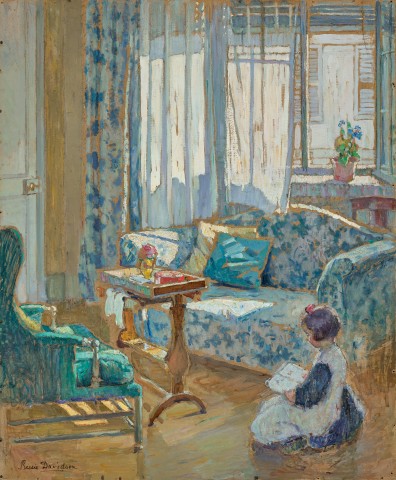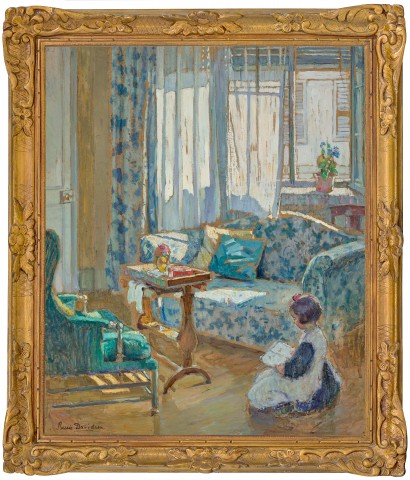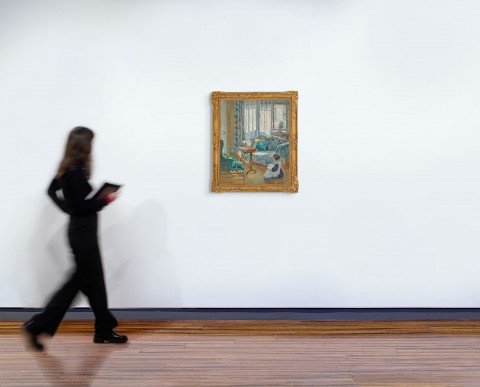(1879 - 1965)
Bessie Davidson
(Interior with girl reading), c.1924
tempera on compressed card
Salon des Tuileries, Palais de Bois, Porte Maillot, Paris, 1924
Mr & Mrs James P. Cordill, New Orleans, USA, acquired in Paris c.1924
Miss Shirley Cordill, New Orleans, USA, a gift from the above
Thence by descent
Private collection, New Orleans, USA
Possibly: Salon des Tuileries, Palais de Bois, Porte Maillot, Paris, 1924, cat. 411-bis (as ‘Intérieur’’)
An interior, c.1920, oil, charcoal on composition board, 73.1 x 59.7 cm, Art Gallery of South Australia, Adelaide
‘The artist is there, you can feel her presence, yet she doesn’t throw herself at you nor leap upon you proclaiming her genius. There is nothing overwhelming in the welcome extended by these interiors, these landscapes. They make no effort to catch your eye or provoke astonishment. These are well-mannered paintings. But the more carefully you look at them, contemplate them, the more they will give up the secret of their discreet charm’.1
This is how Pierre Müller, art critic for Le Courier, characterised the paintings in Bessie Davidson’s first solo exhibition at Galerie Ecalle, Paris, which opened on New Years Eve in 1928. In addition to receiving a positive critical response, the exhibition marked a significant milestone in her career. Almost twenty years after the South Australian-born artist had returned to Paris, settling there permanently, this presentation of sixty works proclaimed her creative self-confidence and boldly staked a place among the ranks of contemporary artists working in France at the time.
Interior with girl reading, c. 1924 is typical of the interiors for which Davidson is best known – painterly celebrations of relaxed feminine domestic spaces that often include a portrait of a female friend or child. The shuttered building visible through the open window locates the scene in Paris, most likely the artist’s second-floor studio apartment on the Rue Boissonade in Montparnasse which had ‘a vast high window composed of tall and slender panes overlooking the courtyard.’2 The furniture and style of decoration also is consistent with contemporary photographs and other paintings of Davidson’s residence. The distinctive green armchair on the left appears to be the same chair that features in the Art Gallery of South Australia’s painting, An interior, c. 1920 and indeed, the child in both works might also be the same subject. As much as this painting delights in the depiction of the patterns, shapes and textures of the elegantly homely furniture and furnishings, it is also a skilful exercise in the pictorial representation of light and shade. Davidson had been praised for the ability to ‘bathe her airy interiors with a luminous transparency’3 and this painting is no exception, capturing the bright shaft of sunlight shining through the windows in a diagonal sequence of brilliant highlights that enliven the scene.
This work is painted in tempera, a medium which the New York Herald reported, ‘Miss Davidson prefers to apply… to cardboard… You can be more spontaneous than with [oils], more solid than with [watercolour]’4, noting that ‘[she] accommodates it with an ease so felicitous that it seems not so much a tool as a toy.’5 Revealing something of Davidson’s process, traces of preliminary underdrawing are visible throughout the image, as are sections of the cardboard support that remain unpainted (seen here most clearly in the shutters on the building opposite). A technique that was also used by artists including Édouard Vuillard and Pierre Bonnard, incorporating the exposed board into the final composition of works in both tempera and in oil gives Davidson’s paintings an energy that speaks to the passion with which they were made.
1. Pierre Müller, cited in Little, P., A Studio in Montparnasse: Bessie Davidson: An Australian Artist in Paris, Craftsman House, Melbourne, 2003, pp. 99 – 100
2. ibid., p. 55
3. ibid, p. 90
4. See Little, ibid., p. 89
5. ibid.
KIRSTY GRANT


